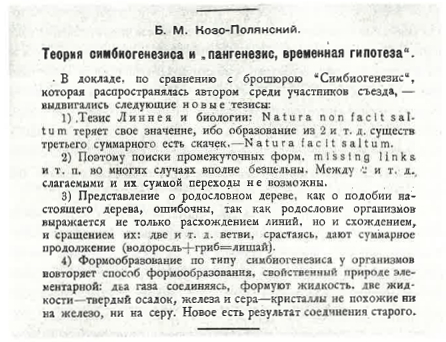|
Gypsophila Litwinowii
''Gypsophila litwinowii'' is a species of flowering plant in the family Caryophyllaceae, native to central European Russia, northwest of Voronezh. It is confined to chalk outcrops. References Gypsophila, litwinowii Endemic flora of Russia Flora of Central European Russia Plants described in 1922 {{Caryophyllaceae-stub ... [...More Info...] [...Related Items...] OR: [Wikipedia] [Google] [Baidu] |
Boris Kozo-Polyansky
Boris Mikhailovich Kozo-Polyansky (; 20 January 1890 – 21 April 1957) was a Soviet and Russian botanist and evolutionary biologist, best known for his seminal work, ''Symbiogenesis: A New Principle of Evolution'', which was the first work to place the theory of symbiogenesis into a Darwinian evolutionary context, as well as one of the first to redefine cell theory. Life Boris Kozo-Polyansky was born in Ashgabat, which at the time was part of the Russian Empire. He relocated to Voronezh in his early youth.Prokhorov, A. M. (Aleksandr Mikhaĭlovich). Great Soviet Encyclopedia. New York: Macmillan, 1973. He graduated from Moscow University in 1914 at the age of 24, before returning to Voronezh where he worked as an assistant at Voronezh Agricultural University until 1918. In 1920 he then became a professor at Voronezh State University, where he taught for the remainder of his life and served as a Dean, Chair of Botany and Vice President of the University. He is buried in Voronezh ... [...More Info...] [...Related Items...] OR: [Wikipedia] [Google] [Baidu] |
Caryophyllaceae
Caryophyllaceae, commonly called the pink family or carnation family, is a family of flowering plants. It is included in the dicotyledon order Caryophyllales in the APG III system, alongside 33 other families, including Amaranthaceae, Cactaceae, and Polygonaceae. It is a large family, with 81 genera and about 2,625 known species. This cosmopolitan family of mostly herbaceous plants is best represented in temperate climates, with a few species growing on tropical mountains. Some of the more commonly known members include pinks and carnations (''Dianthus''), and firepink and campions ('' Lychnis'' and ''Silene''). Many species are grown as ornamental plants, and some species are widespread weeds. Most species grow in the Mediterranean and bordering regions of Europe and Asia. The number of genera and species in the Southern Hemisphere is rather small, although the family does contain Antarctic pearlwort (''Colobanthus quitensis''), the world's southernmost dicot, which is one ... [...More Info...] [...Related Items...] OR: [Wikipedia] [Google] [Baidu] |
Voronezh
Voronezh ( rus, links=no, Воро́неж, p=vɐˈronʲɪʂ}) is a city and the administrative centre of Voronezh Oblast in southwestern Russia straddling the Voronezh River, located from where it flows into the Don River. The city sits on the Southeastern Railway, which connects western Russia with the Urals and Siberia, the Caucasus and Ukraine, and the M4 highway (Moscow–Voronezh–Rostov-on-Don– Novorossiysk). In recent years the city has experienced rapid population growth, rising in 2021 to 1,057,681, up from 889,680 recorded in the 2010 Census; making it the fourteenth most populous city in the country. Geography Urban layout Information about the original urban layout of Voronezh is contained in the "Patrol Book" of 1615. At that time, the city fortress was logged and located on the banks of the Voronezh River. In plan, it was an irregular quadrangle with a perimeter of about 130 fathoms (238 m), that is, it was very small: inside it, due to lack of space, ... [...More Info...] [...Related Items...] OR: [Wikipedia] [Google] [Baidu] |
Gypsophila
''Gypsophila'' () is a genus of flowering plants in the carnation family, Caryophyllaceae. They are native to Eurasia, Africa, Australia, and the Pacific Islands.''Gypsophila''. Flora of North America. has a particularly high diversity of ''Gypsophila'' taxa, with about 35 species. Some ''Gypsophila'' are in other regions. The genus name is from the |
Endemic Flora Of Russia
Endemism is the state of a species being found in a single defined geographic location, such as an island, state, nation, country or other defined zone; organisms that are indigenous to a place are not endemic to it if they are also found elsewhere. For example, the Cape sugarbird is found exclusively in southwestern South Africa and is therefore said to be ''endemic'' to that particular part of the world. An endemic species can be also be referred to as an ''endemism'' or in scientific literature as an ''endemite''. For example '' Cytisus aeolicus'' is an endemite of the Italian flora. '' Adzharia renschi'' was once believed to be an endemite of the Caucasus, but it was later discovered to be a non-indigenous species from South America belonging to a different genus. The extreme opposite of an endemic species is one with a cosmopolitan distribution, having a global or widespread range. A rare alternative term for a species that is endemic is "precinctive", which applies to ... [...More Info...] [...Related Items...] OR: [Wikipedia] [Google] [Baidu] |
Flora Of Central European Russia
Flora (: floras or florae) is all the plant life present in a particular region or time, generally the naturally occurring (indigenous) native plants. The corresponding term for animals is ''fauna'', and for fungi, it is ''funga''. Sometimes bacteria and fungi are also referred to as flora as in the terms ''gut flora'' or ''skin flora''. Etymology The word "flora" comes from the Latin name of Flora, the goddess of plants, flowers, and fertility in Roman mythology. The technical term "flora" is then derived from a metonymy of this goddess at the end of the sixteenth century. It was first used in poetry to denote the natural vegetation of an area, but soon also assumed the meaning of a work cataloguing such vegetation. Moreover, "Flora" was used to refer to the flowers of an artificial garden in the seventeenth century. The distinction between vegetation (the general appearance of a community) and flora (the taxonomic composition of a community) was first made by Jules Thurmann ... [...More Info...] [...Related Items...] OR: [Wikipedia] [Google] [Baidu] |


.jpg)
.jpg)
